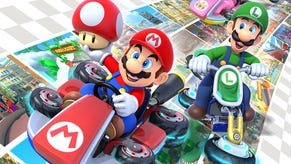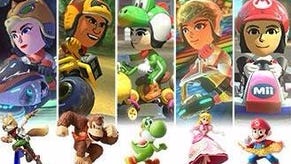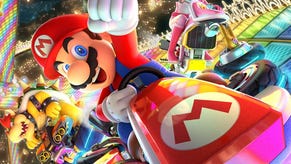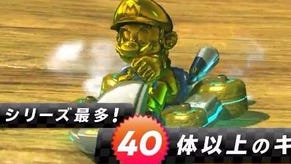Mario Kart 8 review
Lucky number eight.
It's been 22 years since Super Mario Kart and Nintendo's knockabout racing series has held its ground against the only critic whose opinion truly matters: time. Few other game series have been so dependable. Mario Kart has made a regular appearance on each successive piece of Nintendo hardware, always retaining the essence of that triumphant debut, always fending off the imitators following in its slipstream. It's been a journey defined by incremental improvements and amendments, never by reinvention: a new power-up here, an few extra characters there.
And yet Mario Kart 8 is a revelation. It's undiminished by familiarity. It may be furnished with recognisable props, faces, scenes and modes - but it's also the most vibrant home console racing game in years.
Start not with the screen - a window into the Mario multiverse that has never before loomed so large and vivid - but with the hands. Here, at the physical level, you begin to understand the connection this game establishes with its player. As well as managing the gas, brake and steering, your fingers and thumbs must also tap out curious rhythms as they squeeze you into a drift-boost corner - the longer you hold the drift trigger, the greater the boost you receive on release - and fire a trigger as you sail from the crest of a mound in order to perform a speed-boosting stunt.

You must tilt your kart through the air as it glides from the tallest jumps, or through the water as it transforms into an amphibious craft with a pop-up propeller. For the first time in the series, the tracks swerve upwards and loop through the air with an F-Zero-style flourish: during these sections, your kart's wheels tuck beneath the chassis and, using anti-grav propulsion, you flit between the booster pinball bumpers that litter these sections of the track. This pitter-patter of interactions, of jabs and squeezes, connects you intimately to the game. You are needed here, more so than in most other racing games.
To enjoy the pay-off for all this touchy-feely stuff you turn to the screen, which Mario Kart 8 lights up with rare vibrancy. The game's visual glory resides in its sense of scale, naturally: vast stadiums, giant seaside cities, titanic ruins. Toad Harbour is San Francisco by way of the Mushroom Kingdom, complete with trundling trams and nosebleed descents. Shy Guy Falls sees you drive up two enormous waterfalls. Cloudtop Cruise is a spectacular tour through the heavens, accompanied by a joyful burst of Super Mario Galaxy's Gusty Garden theme. Sunshine Airport, set on Super Mario Sunshine's Delfino island (where you're waved on by tilting Piantas), has you glide towards jumbo jets on take-off, while Dolphin Shoals challenges you to drive along the back of a giant conger eel. Perhaps the most memorable track of the new set, Mount Wario, is a winding point-to-point race which begins when the karts drop from the cargo hold of a plane and ends, minutes later, at the bottom of a slalom-crossed mountain.
But it's in some exquisite details, too: the way that Toadette's pigtails (each one a string of pink mushrooms) flap in the furious breeze; the upturned ice-cream cones used as road markers in Sweet Sweet Canyon; the stitching on the karts' kites; their finely painted, Mario-themed racing liveries; the birds that scatter off the Moo Moo Meadows' mud track. It's in the way that your racer will turn their head to glance at a rival as they streak past and it's in the look of dismay that crinkles across their face when struck by an incoming shell. All of this weight and attention, all delivered in an unflinching 60 frames per second. Video games have been this detailed before, but never with such imagination, grace and humour.
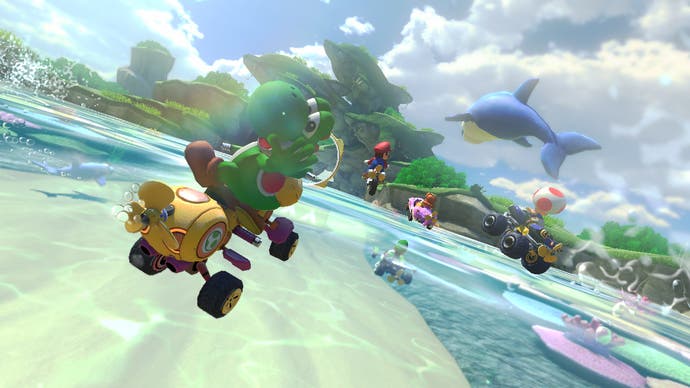
These minutiae can be celebrated in MKTV, a kind of Fisher Price replay editing tool, which presents a highlight reel of the key moments in each race for post-match viewing. For local multiplayer sessions in particular, re-watching the race via MKTV is a wonderfully happy experience. You switch the action to slow-mo, cheer and gloat at others' misfortunes, roll your eyes at your own mistakes. You can tweak the algorithm to focus the camera on different kinds of highlights (items, hits, spectacular drifts) and choose whether you want the reel to last for 30, 45 or 60 seconds. It's even possible to upload the footage straight to YouTube - the first time that the planet's most insular game publisher has connected in this way with the online world.
On the road (and sand, water, air, lava and rock), this is Mario Kart tuned. As with its immediate predecessor, the 3DS' Mario Kart 7, you piece together your kart's body, wheels and glider before the race, and the chosen combination can have a huge effect on the feel of the game. Each of the racers also has their own strengths and weaknesses, so the number of permutations is extraordinary. Confident players will emphasise top speed over acceleration, while the cautious will favour handling and grip. You'll soon settle upon your favourite. The kart's stats resulting from your choices can be viewed before you race, although the option is tucked away somewhat; Nintendo prefers to present simplistically and leave the stat-squeezing tinkering to the most dedicated.
Each track has a clutch of shortcuts, but they come with an element of risk: fail to negotiate a clean entry and exit and, in most cases, you'd have been better off sticking to the main route. Then there are the power-ups, which dynamically favour those at the back of the pack. In addition to the Lucky 8, a rare gift that offers you eight items all at once, there are three new items: the Super Horn, which emits a defensive shock wave and can be used to fend off even a blue shell; the Piranha Plant, which is held in the character's hand and bites down nearby rivals and items; and the Boomerang, which can be hurled three times to send a rival into a spin.
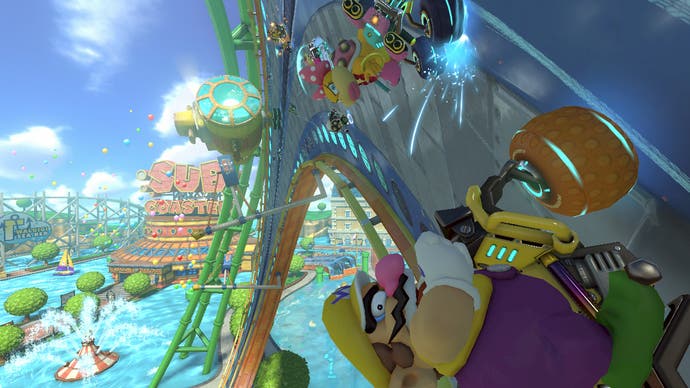
With its game-changing power-ups, Mario Kart has always been game about the tussle between chaos and control. Nintendo understands the value of capriciousness - even if you will curse their approach the 20th time you're struck by a red shell mere metres before the finish line and you tumble down the rankings. For racing game fans for whom all this randomness is anathema, Mario Kart 8's time trials offer the true and enduring depth of the game. Here you choose your set-up and, with just three nitrous mushroom power-ups, attempt to post the best three lap time on each of the game's courses.
Times are measured to a thousandth of a second but, inexplicably, there's no searchable online leaderboard for each track. The best you can do is search for other players' ghost data (up to four can be downloaded and raced against), an option that allows you to view the top times posted for each track. You won't, however, be equipped to post the quickest times without first unlocking the final kart and wheels in the game. This is done by diligently collecting the coins littered on each track, up to 10 per race, which unlock new karts and items when you've collected enough.
Up to 12 players can take part in single races or tournaments online, the rules of which can be tweaked. But communal Mario Kart is, as ever,best played together in the same room. Two-player split-screen races are as fast-running and high-resolution as the solo game, but with three or four players on-screen at once, the frame rate drops significantly. It's a noticeable sacrifice. Alongside tournaments, Battle Mode allows 12 characters to attempt to pop each others' three balloons on eight of the tracks seen elsewhere in the game (minus their anti-grav sections). The move from the arenas used in previous versions of Battle Mode to traditional tracks is a curious one and there's less frequent conflict as a result; everyone is either churning with or against the tide.
Bold, accessible, deep and rich, Mario Kart 8 is premium video game development
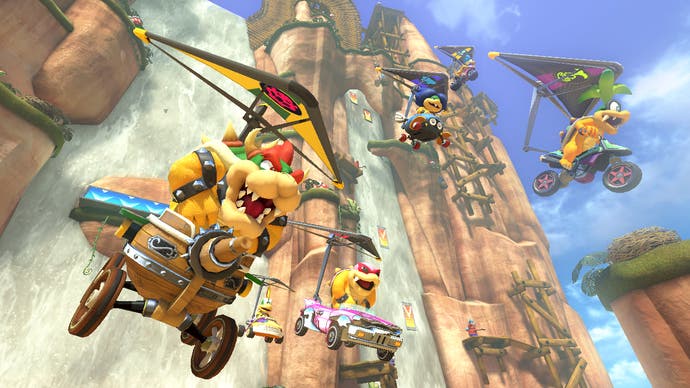
Bold, accessible, deep and rich, Mario Kart 8 is premium video game development. It feels expensive. But this isn't the vacuous lavishness of the Hollywood blockbuster; its excesses and indulgences work towards a common goal - or rather, finish line. The game may build upon some of the steady inventions of its predecessor (the diversity of handling options, the airborne sections) but in these staggering, monument-like arenas, those ideas have been given space to fully blossom.
Video game players are familiar with the law of diminishing returns. Even as new entries in a series tirelessly improve upon their predecessors, our interest nevertheless wanes; with games, improved is somehow less exciting than new. Mario Kart 8 is a rare thing, then: the best entry in a series and the most exciting yet.





